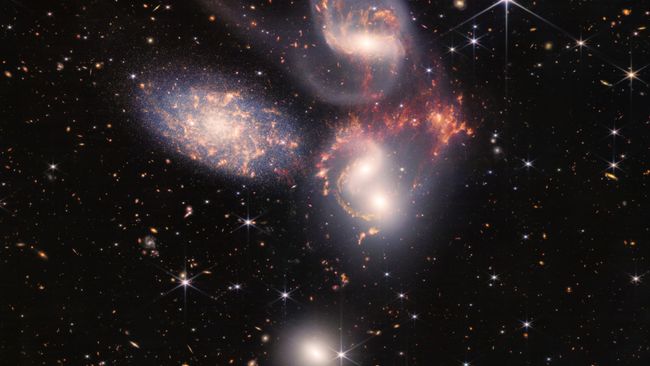The results of computational experiments showed that taking into account the effects of interaction between gas and dark matter leads to new ideas about early galaxies
Space Telescope «James Webb» (JWST) can help solve one of the most mysterious problems of modern astrophysics — lifting the curtain on the mystery of dark matter. In recent studies, scientists at the University of California have conducted simulations of the evolution of the Universe, starting from the “moment of its birth,” the Big Bang. The results indicate that JWST could play a key role in penetrating the very depths of this mysterious cosmic structure.
Dwarf galaxies, which can be found almost everywhere in the Universe, may be early forms of galaxies. They represent a key object for studying the processes underlying the formation and evolution of the entire Universe. However, the observed characteristics of these galaxies do not always correspond to the predictions. They are less dense or spinning faster than simulations predict. This is where the mysterious dark matter comes to the rescue.
Scientists have concluded that the discrepancies may be caused by incorrect consideration of the interaction of dark matter with galactic gas. New computational experiments that took these interactions into account revealed that early galaxies were much brighter and smaller than previous models predicted. Moreover, scientists discovered that the process of galaxy formation was much more intense and faster than previously thought.
In light of these results, the study authors propose to intensify the search for bright and small dwarf galaxies using JWST. Moreover, if such galaxies are not discovered, this may indicate that existing theories of dark matter need to be revised.
Dark matter practically does not interact with electromagnetic radiation and has no luminosity. Unlike traditional, baryonic matter, which is made of atoms, dark matter consists of a form of matter that does not have an electromagnetic charge or the ability to emit light. Its presence can be detected through the gravitational effects it has on surrounding baryonic matter and even light. In fact, the assumption of the existence of dark matter arose due to the discrepancy between the observed parameters of the motion of galaxies and the expected values determined solely through the gravitational effect of ordinary matter.
Scientists also believe that most galaxies are surrounded by huge clouds of dark matter that extend well beyond the visible boundary of the galaxies. They suggest that these clouds played a key role in the process of formation and evolution of galaxies.
According to the standard cosmological model, the gravitational influence of dark matter clusters attracts and combines atoms of baryonic matter, which ultimately leads to the formation of stars and galaxies. However, the standard model of cosmology, which is used to explain the evolution of the Universe, does not take into account an important phenomenon — dark matter streaming. This means that the model does not take into account the transfer of dark matter from one region to another.
The experiment established that dark matter streaming plays an important role in the formation of stars and galaxies in the early history of the Universe. The model showed that previously baryonic matter in the form of hydrogen and helium gas, formed after the Big Bang, moved past dark matter clusters at supersonic speeds. Thus, the gas did not get into the «accumulation traps» and could not form stars.
However, over time, the gas gradually «fell» back into galaxies, causing intense star formation. As a result, these galaxies produced many more young, hot stars than ordinary small galaxies. Scientists predict that these types of galaxies could be discovered using the JWST telescope, which can detect the light of these small but bright galaxies.
Researchers note that the discovery of these small, bright galaxies in the early Universe would support the streaming-based model of “cold dark matter.” However, if galaxies of this type are not discovered, this may indicate a change in the properties of dark matter and the need to revise the existing model.

